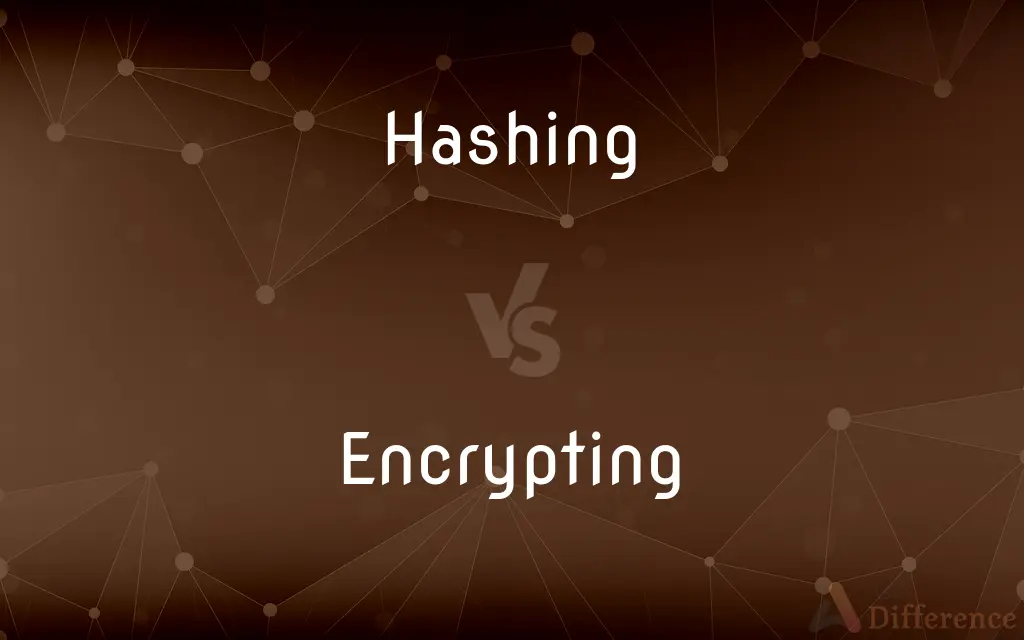Hashing vs. Encrypting — What's the Difference?
Edited by Tayyaba Rehman — By Fiza Rafique — Published on December 9, 2023
Hashing transforms data into a fixed-size value, usually for verification, while encrypting converts data into a secret format, with the intent of decryption.

Difference Between Hashing and Encrypting
Table of Contents
ADVERTISEMENT
Key Differences
Hashing involves taking input data and producing a fixed-length string, which represents that data. Regardless of the input size, the output, known as a hash, remains constant in length. Encrypting, on the other hand, is the process of converting data into a secret format to protect its confidentiality. The intention is that only someone possessing the appropriate key can revert the data to its original form.
The primary purpose of hashing is to ensure data integrity and verify that content has not been altered. A tiny change in the input results in a drastically different hash. With encrypting, the aim is to shield data from unauthorized access. If one possesses the correct decryption key, they can revert encrypted data back to its original format.
It's worth noting that hashing is a one-way function. Once data has been hashed, it cannot be reverted to its original state. Encrypting, in contrast, is designed to be a two-way process. Data that has been encrypted can be decrypted, provided the correct key is used.
Although both hashing and encrypting are mechanisms to protect data, their applications differ. Hashing is commonly used in data verification, password storage, and digital signatures. Encrypting is prevalent in protecting sensitive data during transmission or when stored, ensuring that only authorized parties can access the original data.
Comparison Chart
Purpose
Ensure data integrity and verification.
Protect data confidentiality.
ADVERTISEMENT
Output Length
Fixed-length.
Variable-length based on input and encryption algorithm.
Reversibility
One-way function; can't retrieve original data.
Two-way; can revert to original data with a key.
Primary Use Cases
Data verification, password storage, digital signatures.
Data protection during transmission and storage.
Key Requirement
No key required for hashing.
Key required for encryption and decryption.
Compare with Definitions
Hashing
Creates a unique representation for different data inputs.
Two distinct files will have different hash values.
Encrypting
The process of converting data into a coded format.
Sensitive information is often encrypted before transmission.
Hashing
A mechanism ensuring data hasn't been tampered with.
File downloads sometimes come with a hash value for verification.
Encrypting
Aims to protect data from unauthorized access.
Encrypted files require a key for decryption.
Hashing
A process to convert data into a fixed-size value.
Websites often use hashing for storing user passwords securely.
Encrypting
Uses a key for both the encryption and decryption processes.
Without the correct key, decrypting an encrypted message is challenging.
Hashing
A one-way transformation of data.
Once data is hashed, you can't revert it to its original form.
Encrypting
Shields sensitive data both in transit and at rest.
Online payments use encryption to protect credit card details.
Hashing
Frequently used in digital signatures.
Digital documents are often signed using hashing algorithms.
Encrypting
A reversible way to mask data.
Encrypted emails can be decrypted by the recipient using the right key.
Hashing
A dish of chopped meat, potatoes, and sometimes vegetables, usually browned.
Encrypting
To put into code or cipher.
Hashing
A jumble; a hodgepodge.
Encrypting
(Computers) To alter (data) using a mathematical algorithm so as to make the data unintelligible to unauthorized users while allowing a user with a key or password to convert the altered data back to its original state.
Hashing
(Informal) A mess
Made a hash of the project.
Encrypting
Infl of encrypt
Hashing
A reworking or restatement of already familiar material.
Hashing
To chop into pieces; mince.
Hashing
(Informal) To make a mess of; mangle.
Hashing
(Informal) To discuss carefully; review
Hash over future plans.
Hash out a solution.
Hashing
A social, non-competitive sport in which participants of a hash run use clues to follow a hash trail.
Hashing
Present participle of hash
Common Curiosities
Is hashing reversible?
No, hashing is a one-way function and is not reversible.
Is a key necessary for encryption?
Yes, a key is essential for both encrypting and decrypting data.
Why is hashing used for passwords?
Hashing ensures passwords are stored securely and verifies them without revealing the actual password.
What's the difference between symmetric and asymmetric encryption?
Symmetric encryption uses one key for both encryption and decryption, while asymmetric uses a public key for encryption and a private key for decryption.
What happens if I lose my encryption key?
If you lose your encryption key, decrypting the data becomes nearly impossible.
Do I need to encrypt data stored on my personal computer?
Encrypting data on personal devices is recommended, especially if it's sensitive or personal.
What happens if two different inputs produce the same hash?
This is called a hash collision, and it's a concern in cryptographic contexts.
Is hashing used only for security purposes?
No, hashing has various applications, including data verification and storage optimization.
Can encrypted data be decrypted?
Yes, encrypted data can be decrypted using the appropriate key.
Why is encryption important for online transactions?
Encryption protects sensitive data, like credit card numbers, during online transactions.
Can I determine the original content from a hash?
No, hashing is one-way, and original content can't be determined from its hash.
Are all hashing algorithms equally secure?
No, some hashing algorithms are considered more secure than others, and their security can change over time.
Why might two different files produce the same hash?
This is a rare occurrence called a collision and is undesirable in cryptographic hash functions.
Which is faster, hashing or encrypting?
Hashing is generally faster as it produces a fixed-size output, but speed varies based on the algorithm and data size.
Can encrypted data be intercepted during transmission?
It can be intercepted, but without the decryption key, the data remains unreadable.
Share Your Discovery

Previous Comparison
Elastic Deformation vs. Plastic Deformation
Next Comparison
Akbash vs. Great PyreneesAuthor Spotlight
Written by
Fiza RafiqueFiza Rafique is a skilled content writer at AskDifference.com, where she meticulously refines and enhances written pieces. Drawing from her vast editorial expertise, Fiza ensures clarity, accuracy, and precision in every article. Passionate about language, she continually seeks to elevate the quality of content for readers worldwide.
Edited by
Tayyaba RehmanTayyaba Rehman is a distinguished writer, currently serving as a primary contributor to askdifference.com. As a researcher in semantics and etymology, Tayyaba's passion for the complexity of languages and their distinctions has found a perfect home on the platform. Tayyaba delves into the intricacies of language, distinguishing between commonly confused words and phrases, thereby providing clarity for readers worldwide.













































